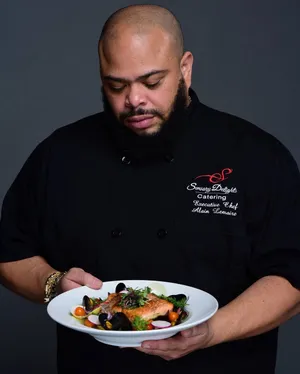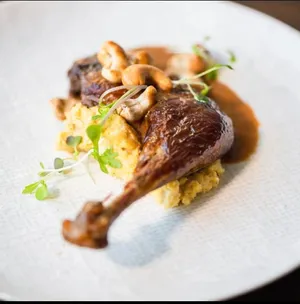Don't listen to Trump's lies. Haitian chef explains country's rich culinary tradition.
Based on the headlines this week, it seems too many Americans don’t have any Haitian friends - and certainly don’t understand their rich food culture.
I say this because of the nonsensical, bigoted and tired trope about immigrants eating people's cats and dogs that former President Donald Trump regurgitated during Tuesday's presidential debate with Vice President Kamala Harris. This time, the trope sprang from a social media post about Haitian immigrants in Springfield, Ohio.
It's not just mean and stupid: It's the kind of far-right dog whistle that can also be dangerous.
Anyone lucky enough to have Haitian friends and food in their lives knows about the complex flavors of soup joumou, a Sunday-only squash and beef soup, or the famed citrus-marinated pork shoulder, griot. They know about the spicy deliciousness of the condiment of condiments: pikliz. And they surely know the queen of all rums: Haiti's famed Rhum Barbancourt.
"Po diab pou yo." Too bad for them.
Not one to miss an opportunity to talk about food, I reached out to Miami-based, award-winning chef Alain Lemaire, who has appeared on the "Luda Can't Cook" series on Discovery+ with rapper, actor and restauranteur Chris "Ludacris" Bridges. We talked Haitian food, Haitian families, and what cooking and eating together means to Haitian people.
Chef Lemaire even blessed this column with a recipe at the end.
This interview has been edited for length and clarity. The opinions above are those of Carli Pierson and do not reflect the opinions of Chef Alain Lemaire.
What made you get into cooking and why Haitian food?
It was a necessity to cook for myself: What I wanted to eat and when I wanted to eat. I was born and raised in Haiti. Growing up in the Caribbean in the '80s and '90s, there was a strict policy of "Whatever there is to eat at the house, you have to eat it."

I paid attention to how they cooked the dishes I loved. So, when my mom was at work, I would go back in the kitchen and recreate them for myself.
What were your favorite dishes as a kid?
This is going to sound ridiculous but we eat spaghetti for breakfast. So, there were two meals I loved cooking. One was spaghetti and the the other was bulgur wheat with beef and sauce: It's called "ble." I mastered these growing up.
Immigrants aren't eating pets:Tell Trump I have 'proof' Vance ate my cat
Where in Haiti did you grow up?
Port-au-Prince, in Delmas.
When did you decide to make a career of cooking?
After graduating high school in 2000, I came to Miami.
While I was back home in Haiti, I was trying to decide what I wanted to pursue. In Miami, I had a friend who was going to a culinary program at Johnson & Wales, and when I came I fell in love with the program right then and there.
What kinds of reactions do you see from people trying Haitian food for the first time?

The shocked expressions when they taste our dishes. It's not a unilateral landscape of flavors: It's layers of flavors. Especially if the food is well seasoned. Also, our Haitian cuisine is a mix of African, French, Spanish and even some Middle Eastern flavors. When you talk about the slave trade, the spice trade, migration from Arab countries: Everyone brought their spices and flavors with them.
This is what Haitian cuisine is all about.
What is your favorite dish to cook now if you had to pick one?
That's difficult. It would have to be lalo: It's more dominant in the central part of Haiti. It's a dish made with jute leaves and some people add crabs and beef, also. Traditionally, it's served with white rice and "sos pwa" (pepper sauce).
Trump lies about immigrants hide truth:They pay their share of taxes
What would you like people to know about Haitian food and Haitian people?
Haitian food is very rich, flavorful; it's bold, fresh and in your face. It is the heart of what we represent because food for us is not only about nutrition, but it brings everybody together. Every celebration involves food. It's about unity and strength.
Our food also comes out of struggle, the fight we have to endure and out of making the best of what we have available.
Chef Lemaire's creole chicken with cashews recipe

- Yield: 4 servings
- Prep time: 4 hours
- Cooking time: 45 minutes
- Total time: 4 hours and 45 minutes
Ingredients:
- 4 chicken leg quarters, cut in two
- 6 ounces tomato paste
- 1-quart chicken stock or broth
- 6 ounces epis: Blended thyme, garlic, parsley, scotch bonnet peppers, salt, sometimes oil or citrus, onions and sweet peppers
- 1/2 cup cashew halves, toasted
- 2 tablespoons finely ground cashews
- 1 bouquet garni (wrapped up in a cheesecloth): 3 thyme sprigs, a bunch of parsley stems, 2 heads of scallions, 1 habanero pepper, 5 whole peppercorns, 2 whole cloves and 3 heads of garlic
- 1/2 green bell pepper, julienne
- 1/2 yellow onion, julienne
- canola oil for cooking
- salt and pepper to taste
Method of preparation:
- Season chicken with epis, salt and pepper. Place in a container and let marinate overnight or for 3 to 4 hours.
- Heat a dense pot, add some oil and sear chicken in small batches until golden brown on each side. Remove and set aside.
- In same pan, add tomato paste and cook on low heat until well dissolved. About 2 minutes.
- Pour in chicken stock/broth then mix in cashew powder until well dissolved.
- Add chicken pieces, and bouquet garni. Make sure chicken is at least three-quarters submerged. Adjust seasoning, bring to a boil then let simmer.
- Once chicken has reached an internal temperature of 165°F, and sauce is silky, add cashew halves, onions and peppers.
- Let cook for an additional 7 minutes.
- Serving suggestions: Serve with white rice and avocados.
Carli Pierson is a Voices/Opinion editor at USA TODAY.
Disclaimer: The copyright of this article belongs to the original author. Reposting this article is solely for the purpose of information dissemination and does not constitute any investment advice. If there is any infringement, please contact us immediately. We will make corrections or deletions as necessary. Thank you.







